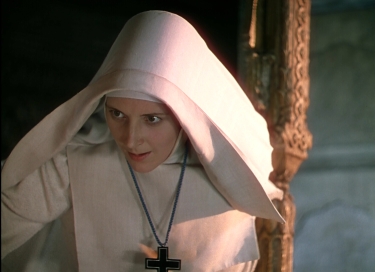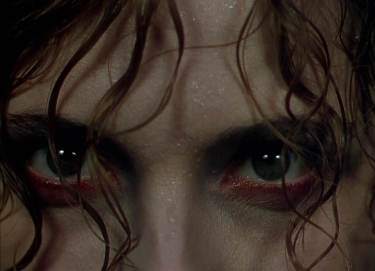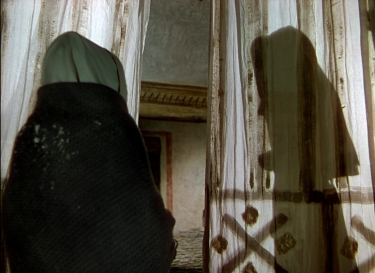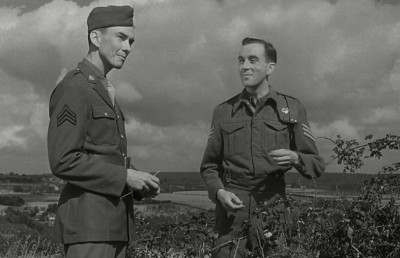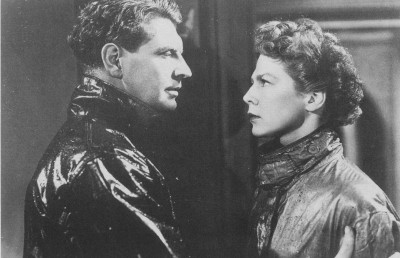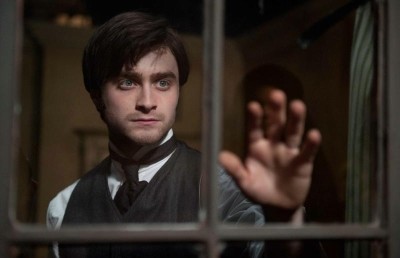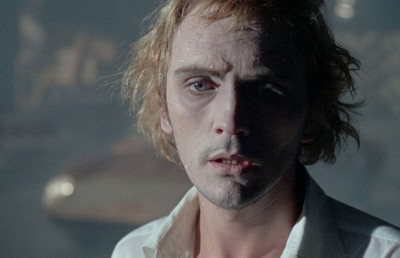Bloodcurdling Holiness in Black Narcissus
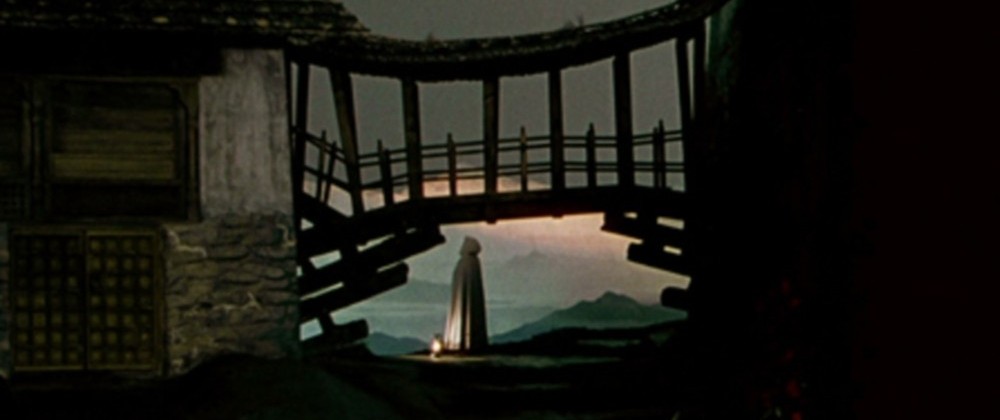
“Sexuality is the monster that makes victims of the innocent and wreaks havoc in an otherwise peaceful world.” – Chris Meyers and Sara Waller (117)
“One needs here both to distinguish between the concepts of repression and oppression, and to suggest the continuity between them.” – Robin Wood (8)
Of all films to emerge from the Michael Powell & Emeric Pressburger creative union, Black Narcissus (1947) is perhaps most overtly infused with elements of horror and fantasy. It also stands out from their catalog of lush collaborative visions as a sort of ‘great equalizer’—capable of catering to both ‘high brow’ audiences with its meticulously designed mise-en-scene, socio-political subtext, and literature-based colonial backdrop, as much as it can satiate a more ‘cult’ or ‘midnight movie’ crowd’s appetite with its vibrant Technicolor, at-times operatic (some would argue campy) aesthetic/textual excess, and – as we shall examine – its employment of horror iconography and style. Much of this horrific verve stems from the film’s dominant theme of repressed sexuality and its localization and scapegoating of an ‘Other’—both recurrent aspects not only in colonial discourse, but also in the horror genre, as elucidated by Robin Wood in his seminal 1978 essay, “The Return of the Repressed.” However, the horror flavor of the film not only manifests in its thematic charge, but also through its very sensual atmosphere – an ornate Gothic space that is saturated with creaking, billowing, transformative winds, expressionistic chiaroscuro, and vivid coloring – and the way it frames characters in striking ways within this lyrical environment. Adopting the horror genre and its many consternating tenets as a prism to view the film through, this essay will explore how repressed sexuality, when combined with ‘Otherness,’ can have monstrous results, and how expressive spaces and potent psychodrama (flashbacks & hysteria & madness, oh my!) generate hair-raising tension.
Although Black Narcissus can be seen as a hybrid of genres – from colonial or religious satire to melodramatic art film and noir thriller – for the sake of this analysis, it might best be construed as a ‘dark fairy tale’; as borrowing the fantastical, oneiric qualities of a remote enchanted world – as evidenced by Mopu Palace’s mythical illustration in a book at the opening (2:34-2:38) – but in accordance with its ties to horror, also harboring an oppressive undercurrent that gradually works its way to the surface, and deters the story from reaching a happy conclusion. Since Mopu itself is not sinister, it is the innate beauty and esoteric, ‘hidden’ energy of this native Indian land that threatens the Sisters’ rigid lifestyle, exemplified by the Holy Man who – “always in his place under the tree” (46:00) – is posited in stoic symbiotic relation with the very heartbeat of Mopu’s landscape, wind, and tribal drumming (24:13-24:23), and is pitted against the nuns’ prayers and orderly bell-ringing, the latter of which is, ironically, a re-appropriated “pagan relic used for summoning to prayer, and planted right on the edge of the steep and deadly precipice” (Sheehan, 39).
Therefore, scrutiny of the film’s horror is in a sense inextricable from a treatment of its fantasy. The setting is both a ‘castle in the clouds’ – literalized at the ending when it is shrouded by fog (1:37:53-1:38:00) – and a cliff-lurking structure that is simply waiting for the proverbial ball to drop. It represents the uncanny space of fairy tales, the insular site of physical and ideological struggle in horror, and in both cases, the ‘other side of the threshold’ which is not only occupied by foreign ‘Others’, but also germinates a forgotten sense of Otherness within the repressed nuns. The breeze carries with it the power to open up dark recesses of the mind, to collapse past memory into present sensation, and in short, to make the repressed return, as Wood might have argued.
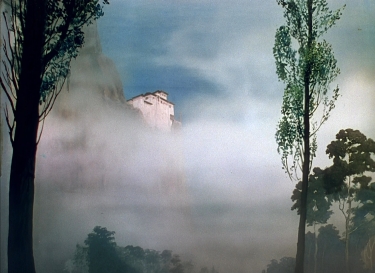
Powell & Pressburger, having verbalized a great affinity for Walt Disney’s lofty body of work and brilliant use of color, only reinforces a viewer’s reading of the film as fantastical. However, as H. Sheehan observes of P & P’s distinctly non-Freudian tendencies (and unlike many fairy tales): “The pair was not lured into the glib semantical sleights-of-hand that saw dragons as sublimated sexual desire; on the contrary, they preferred to discover the dragon hiding behind the desire” (37). When examining the film in terms of overarching sexual repression, its fantastical and horrific aspects – no matter how outlandish or hyperbolized they might come across as – always result from something that is inherently bubbling inside a human, though its emergence may be triggered by exterior forces. Lurid emotions are matched onscreen by aesthetic and textual excess, effectively amplifying the darkness and instability evoked by the nuns.
Like the ghosts that haunt the desolate ‘terrible houses’ that Carol Clover defines in her gender-oriented dissemination of horror films, “Men, Women, and Chain Saws”, location in Black Narcissus too can be interpreted as an almost sentient force—as having a mind and swaying power of its own, haunted by the hedonistic “ghosts of generations past.” Priya Jaikumar accurately describes Mopu’s forcefulness in a colonial light: “the mute place does not merely resist change, it makes its will evident in the colonizers’ minds and bodies as the place revives the Sisters’ memories, erupts in the form of spots and boils on their skin, and incites insomnia and headaches” (65-66). Atmosphere itself tries to possess the nuns by challenging their abstinent ‘unwomanliness’ with a 9000-foot altitude that alters physical and mental mass, allowing the thaw of distant memories, and the germination of lusty impetus. Instead of a ‘terrible house’, location here could more aptly be called a ‘wonderful palace’…although the results are equally gruesome.
Bodies erupt with sores and disease-like symptoms not because the environment is a condemned carrier and proliferator of decay, contagion or torment, but because its unrelenting sensual pulse – because its “water is too good” and because “there’s something in the atmosphere that makes everything seem exaggerated,” as Mr. Dean states (28:02; 1:18:39) – clashes with and tries to melt the repressive layers of these Anglo-Saxon, ideologically invasive nuns. Wood notes that the Other’s “psychoanalytic significance resides in the fact that it functions not simply as something external to the culture or to the self, but also as what is repressed (but never destroyed) in the self and projected outwards in order to be hated and disowned” (9). Therefore, Mopu can be seen as exorcising the nuns’ own latent, interiorized demons – as piecing together an ‘Otherness’ inside them that has previously been displaced with an accusatory finger upon an exotic world and its people – and the intense struggle that ensues between faltering faith and libidinal drive results in reason’s unraveling, and the body’s deterioration. It is through this psychosexual ‘perversion’ of body, mind, and emotion that threads of horror can be traced, and nowhere does this horrific, metamorphosis take greater shape than in the figure of Sister Ruth (Kathleen Byron), who by the end of the film, is rendered as a bona fide monster.
From the moment when Sister Ruth bursts into Sister Clodagh’s (Deborah Kerr) room – her habit spattered with blood following an incident at the nearby village (28:06) – and throws a lusty glance at Mr. Dean (David Farrar) not once but twice (at 28:09 and 28:43) she is ‘marked’, and commences her descent into depravity and madness. Of course, wind is also omnipresent throughout the scene, stirring implicit turmoil and challenging self-restraint. As Natacha Thiéry observes:
From then on, she [Ruth] is more woman than nun. Her white habit, splashed with blood, indicates the sexing of the character. In the same image, menstrual blood and the symbolical loss of virginity are displayed, as they will be again later in the red dress that will replace the uniform and advertise her difference from the rest (230).
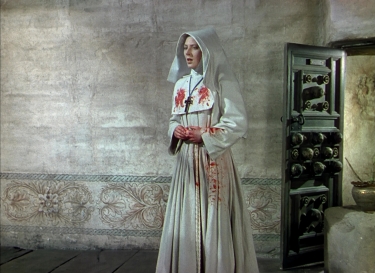
Sister Ruth ends up embodying all the ‘outsider’ qualities and psychosexual tension of humanoid monster archetypes commonly seen in Val Lewton productions of the same era, with the only difference being that she swaps teeth and claws for erotically weaponized lipstick, and feral fur for a sleek crimson dress. As implied by Thiéry, these two moments – her barging into the room, and her revelatory changing of outfits (1:20:46-1:23:48) – are bookends to her ‘monstrous’ transformation from tainted, fraudulent nun to carnal, frenzied woman. After a swish-pan right further solidifies the ‘menacing femininity’ of Ruth as she escapes Clodagh’s careful watch (1:23:55) and proceeds to cackle evilly down a corridor in unsettling harmony with the swelling operatic voices on the score, the other nuns search for her with all the desperation of a village chasing Frankenstein’s monster by torch-light. When Ruth is then seen charging through the jungle and the camera tracks her laterally to the right – revealing increasingly dense layers of green trees and misty bluish earth that emphasizes her red dress (1:25:14-1:25:48) – she is portrayed as a ‘creature of the night’ who is in hot pursuit of Mr. Dean, and the imagery is reminiscent of Little Red Riding Hood if it were spliced with I Walked with a Zombie (1943) and the primary-colored, sensually affective atmospherics of Dario Argento’s Suspiria (1979). On that note, Jack Cardiff’s vibrant cinematography overall, and the bold, low-key lighting schemes used throughout the film – especially its reds and blues – strike an interesting parallel with supernatural ‘60s and ‘70s horror. In any case, this chapter on the DVD is entitled “Breakdown” for good reason.
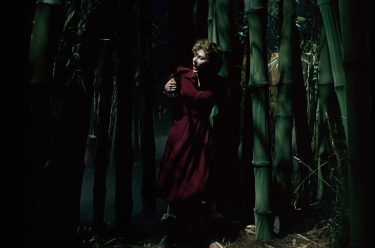
Of course, the full arc of Sister Ruth’s transfiguration into monster is not complete until Dean rejects her, effectively dispelling the only reverie that kept her remaining human element intact. Burning passion is replaced by dark loathing as the frame fades out to fiery red upon rejection, and then fades in from cold blue as Ruth is reborn anew (in a very dead-seeming way) (1:28:24-1:28:33). Sarah Street notes of Cardiff’s vibrant dramatic effects here that “colour can be seen to operate as an excessive register, colouring everything in the frame with the association of anger and jealousy as she cries, ‘Clodagh, Clodagh, Clodagh!’.” (210) The extreme closeup of Ruth’s blackened and ‘voided’ as opposed to bright, gussied up eyes that follows (1:28:46) signals the final death of her humanity as it is supplanted with a yearn for revenge against Sister Clodagh. Previous instances in the film where shafts or spots of light streak Ruth’s eyes with malicious and/or lustful intent (i.e. when Clodagh confronts Ruth about her feelings for Mr. Dean and she is shown grinning diabolically [58:38]; when Ruth spies on Dean from a classroom’s lattice window [34:15] and again later when she eavesdrops on Dean and Clodagh’s penultimate cliff-side conversation [1:16:33-1:20:50]) foreshadow the climactic ‘composed film’ stalking sequence, allowing its impact on the viewer to be both cumulative and imbued with an extra jolt of gravitas and horror.
While discussion of horror in the film should not be limited to this intense and often-discussed end-sequence, many critics have accurately pointed it out as most readily relating to the genre, with an infinitely suggestive use of shadows, suspenseful off-screen space, and psychosexual energy that recalls Jacque Tourneur’s Cat People (1942), and a sense of over-boiling madness, ‘hauntedness’, and a dash of Todorovian ‘fantastic’ that echoes Jack Clayton’s The Innocents (1961).
Horror, psychodrama, and windiness all peak during the meticulously engineered ‘composed film’ sequence that punctuates Black Narcissus (1:31:50-1:35:35). The stalking begins most explicitly with a shock cut (another popular horror convention) to an extreme closeup of Sister Ruth’s abject eyes (1:32:01) that interrupts a serene but brooding Gothic segment where Sister Clodagh’s silhouette gazes out to the mountainside at dawn, her ‘peripatetic’ lantern placed by her feet. (1:30:55-1:32:00). The tension stirred by the thick shadows, slow-moving camera, howling wind, and lilting harp makes this shock cut all the more eerie and compelling. Following this startling cinematic gesture, the floodgates are opened for what is arguably the film’s ‘crowning jewel’, where “Sister Ruth’s climactic stalking features the subjective camera’s restlessly prowling and startling close-ups of red-rimmed eyes, recognizable aesthetic strategies of the horror movie” (189) and more specifically, the ‘slasher’ subgenre that would develop decades later.
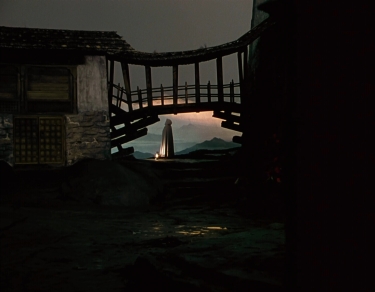
Ruth has become a tragic, liminal, zombie-like creature who straddles the line between waking life and final death, is utterly empty inside yet has a domineering and determined presence, and is incapable of falling back on a previously repressive lifestyle, but even more unable to consummate the desires that this foreign land has cultivated inside of her. Priya puts it more succinctly: “In her intent to kill a woman in prayer and in her macabre visual transformation, she is marked as having finally crossed over beyond the reach of humanity” (68). Ruth’s expressionistic and etiolating make-up, and the fact that her once-perfectly done up ginger hair and red dress have become greasy and coal black to match her eyes, ultimately render her as a pale, emaciated ghoul when the viewer finally sees her standing in full light before the attack on Sister Clodagh (1:34:26).
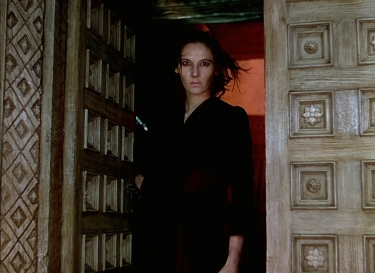
Sister Ruth’s somnambulant-like state hearkens back to Conrad Veidt’s Cesare in The Cabinet of Dr. Caligari (1919), especially when she is seen emerging from a bright orange-lit doorway, and slinks through a hallway’s shadows like an otherworldly assassin (1:34:06-1:34:10). Both figures have lost their autonomy and claim to life. As in Caligari – or even the numinous atmospheres conjured by Carl Theodor Dreyer in Vampyr (1932) and Vredens dag (1943) – P & P optimize psychodrama and tension by lingering on strained, reactive faces in closeup, and by fragmenting identities by illustrating an inner schizoid conflict between reality and illusion, or by channeling themes such as the doppelganger. In Black Narcissus, Ruth and Clodagh form a strange, black-and-white dichotomy that echoes this timeless theme. Brian McFarlane expands on the subject:
…in a brilliant stroke, Powell ensures that Kerr and Byron are often photographed so as to look alike—so that restrain and passion are made to look like two sides of the same coin, and to co-exist in precarious balance. As the effect of the inevitabilities of wind and altitude and disturbingly pure air make themselves felt, so too do other personal inevitabilities, the instincts, force their way through the surface restraints (370).
Clodagh’s flashbacks prove that turmoil is just as present in her being as it is in Ruth’s. Whereas the latter creeps through real darkness and looms behind thresholds (in imitation of the ‘monster-behind-a-window’ motif that would recur in Powell’s Peeping Tom), the former surrenders herself to the ‘voids’ of labyrinthine memory, as in the second flashback when a doorbell rings in her old home, and she runs to meet her ‘love’ only to be absorbed by the total oblivion that waits outside the front door (52:16). The mirroring between Clodagh and Ruth – whether expressed thematically, or compositionally (i.e. when Ruth’s shadowy outline is seen on Christmas Eve behind a curtain frame right as Clodagh enters in front of a curtain frame left with her back to us, facing Ruth, who assumes the graphical position of a dark ‘subconscious’ reflection [56:30]) – adds psychological tension to the narrative that is only relieved when the Sister Superior’s faith ultimately triumphs over her more monstrous half’s loathing.
While other similarities can be traced between Black Narcissus and horror – the inherently tension-producing rigidity and framing of the nuns in their habit; the way extreme religious vocation and depraved ‘possession’ butt heads as in William Friedkin’s The Exorcist (1973); the influence of Vermeer and Caravaggio’s painterly aesthetics on the moody chiaroscuro; the way violence in horror films is also an integral “resolution of all imperial films because it combines cinematic spectacle and narrative catharsis, which restores equilibrium to the story” (Jaikumar, 67) – the grain of what makes this P & P outing so special and groundbreaking for its time cannot be encapsulated by any single comparison or analytical thread. Above all, Black Narcissus modernizes a Romantic sense of the sublime, recalling mountainous vistas of old whose disarming, humbling sense of ‘awe’ often came packing a requisite dose of terror and ‘the unknown’. Based on P & P’s championing of “creative subjectivity,” text becomes universalized somewhat; the filmmakers encourage an audience to be adventurous with their interpretations. Combined with the “tension in Powell and Pressburger between centrality and marginality” (Moor 221) and their glorious, lyrical use of artifice in Black Narcissus allows a cross-cultural appeal that does not expire as the years pass. Even if they might not have intended to expand the definition of cinematic horror and suspense, the dynamic filmmaking duo’s wide aura of influence – much like the potent “??Black Narcissus??” perfume worn by The Young General (Sabu) – breaches unforeseen territory and intoxicates perception by its very nature.
BibliographyJaikumar, Priya. “‘Place’ and the modernist redemption of empire in Black Narcissus.” Cinema Journal v. 40 no. 2 (2001): 57-77.
Keser, R. “Black Narcissus.” Journal of Popular Film and Television v. 34 no. 4 (Winter 2007): 188-9.
McFarlane, Brian. “Michael Powell, Actors and Englishness: Some Late Reflections.” Quarterly Review of Film and Video v. 26 no. 5 (2009): 365-371.
Meyers, Chris and Sara Waller. “Disenstoried Horror: Art Horror Without Narrative.” Film & Philosophy (Special Edition 2001): 117-126.
Moor, Andrew. “Bending the Arrow: The Queer Appeal of the Archers.” The Cinema of Michael Powell. Ed. Ian Christie and Andrew Moor. (London: BFI Publishing, 2005), 209-223.
Sheehan, H. “Black Narcissus.” Film Comment v. 26 (May/June 1990): 37-9.
Street, Sarah. “Analysis.” Black Narcissus. (London: I.B. Tauris, 2005), 30-61, 93-96.
Street, Sarah. “Colour Consciousness: Natalie Kalmus and Technicolor in Britain.” Screen (London, England) v. 50 no. 2 (Summer 2009): 191-215.
Thiéry, Natacha. “That Obscure Subject of Desire: Powell’s Women, 1945-50.” The Cinema of Michael Powell. Ed. Ian Christie and Andrew Moor. (London: BFI Publishing, 2005), 224-238.
Wood, Robin. “An Introduction to the American Horror Film.” The American Nightmare, eds. Robin Wood and Richard Lippe. Toronto: The Festival of Festivals, 1979: 7-28.

